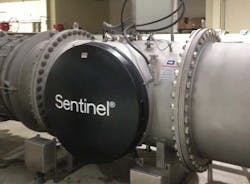Built in the 1990s, the City of Scottsdale Water Campus initially consisted of a 20 million gallons per day (MGD) water reclamation plant and a 10 MGD advanced water treatment plant utilizing microfiltration (MF) and reverse osmosis (RO). Upgrades to the advanced water treatment facility in 2011 and 2012 to 24 MGD included a 20 MGD UV reactor to treat NDMA and other potential contaminants. Continuing commitment to the visionary Water Campus concept is allowing Scottsdale to ensure that a reliable, long-term water supply remains available.
Targeting NDMA
NDMA (N-Nitroso-dimethylamine) is a semivolatile organic chemical that is a toxic and carcinogenic water contaminant created by both industrial and natural processes. Except for research purposes, NDMA is no longer intentionally produced in the United States, but through chemical reactions is still unintentionally produced and released from industrial sources such as tanneries, pesticide production facilities and rubber manufacturing plants. Listed as a priority pollutant by the EPA, it also can be an unintended byproduct at wastewater treatment plants, when wastewater is chlorinated during the disinfection process. Because of its toxicity, the Scottsdale Water Campus identified NDMA as a compound to target for treatment.
Treating NDMA With UV Advanced Oxidation
For the primary purpose of increasing capacity for aquifer replenishment, the Scottsdale Water Campus completed a major upgrade to the advanced water treatment plant in 2012. The upgrade added Ultraviolet (UV) Advanced Oxidation to the system for the treatment of NDMA.
UV AOP technology can treat several contaminants that are not easily removed by other technologies. Among these contaminants are NDMA and other “contaminants of emerging concern” (CECs), which are caused mostly by industrial sources, pose danger to human health, have an impact on aquatic life and ecosystems, are a challenge around the world, and are seeing increasing EPA regulation.
Through degradation by direct photolysis, UV AOP technology can effectively treat NDMA, which does not respond well to such technologies as air stripping or granular activated carbon (GAC). It is readily treated by UV because it absorbs photons directly and breaks down through a cleaving of the N-N bond, yielding nitrite and small quantities of dimethylamine. No oxidant is needed but is often added to oxidize other potential contaminants.
Selection of the UV supplier and equipment was based on a rigorous specification and evaluation of both capital costs and the net present value of operating costs over the life of the system. Offering the lowest total cost of ownership and operation by using Medium Pressure UV technology combined with highly efficient turndown capability, the Sentinel 48 AOP UV, now known as Capital Controls® UV system with Sentinel® reactor, was selected as the advanced oxidation process (AOP) UV equipment.
The system, includes 18 x 20 kW UV lamps to treat the peak flow of 20 MGD, treats RO effluent plant. The reactor is configured in a patented chevron lamp arrangement that allows banks of lamps to shut off while still achieving efficient UV treatment.
System advantages:
- uses the highest power medium pressure UV lamps available, resulting in fewer lamps, less maintenance, and a smaller footprint than alternatives.
- the ability to turn off banks of lamps and to turn down lamps to 40% of full power allows the system to tailor the UV power to the plant needs, reducing operating costs and energy use.
- automated controls continuously adjust the lamp power to meet the target Log-destruction of NDMA.
During a 10-day performance trial in February 2012 the system consistently achieved the 1-log (90%) NDMA removal while continuously adjusting the number of operating lamps and lamp power to match varying plant operating conditions.
Editor's Note: Scranton Gillette Communications and the SGC Water Group are not liable for the accuracy, efficacy and validity of the claims made in this piece. The views expressed in this content do not reflect the position of the editorial teams of Water & Wastes Digest, Water Quality Products and Storm Water Solutions.



